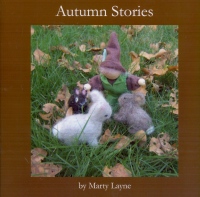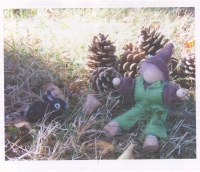| ________________
CM . . . . Volume XVII Number 20. . . .January 28th, 2010. 
 |
Autumn Stories.
Marty Layne.
Victoria, BC: Sea Change Publications, 2010.
32 pp., stapled, $9.99 + shipping.
ISBN 978-0-9682938-6-7.
Preschool / Ages 2-4.
Review by Keith McPherson.
**1/2 / 4
|
| |
|

excerpt:
"We're going for a walk. Do you want to come?" asked Little Brown.
"Sure. Can we walk over to the meadow where there's some very sweet green grass?"
"Good idea Grey Ears. You should both need to get fat and furry and that grass is just the thing. Winter is coming soon. I know because Jackie Frost was here last night. I saw his ice sparkles in the grass this morning," said Little Blue Feather.
Autumn Stories is a picture book containing two short stories centred around the autumn activities of a little doll (Little Blue Feather) and his woodland friends (a dog, squirrel, and three rabbits). In the first story, Little Blue Feather helps his Squirrel-friend gather and store nuts in a hollowed out pumpkin, and in the second story, the doll interacts with rabbits eating clover to store fat for the coming winter months. Both stories develop the reader's awareness of some of the physical changes that autumns brings to the characters' environment.
One of the most striking characteristics of these two stories is that they do not contain convoluted plots or situations that develop tension, crisis, conflict or conditions in the story that require page turning to determine how the characters solve the crisis or diffuse the tension. Instead, readers are presented with a 'simple' imaginative story whose images and storyline capture the characters' relatively trouble-free fall activities.
Children older than four-years will likely find the lack of conflict and relatively uncomplicated storylines to be slow, uneventful, and unappealing. Most of these older children will quickly become disengaged. However, younger children (and children who have difficulty processing story conflict) will likely be attracted to the fantastical storylines, as neither story contains any 'scary' or disturbing situations that may trouble the imagination. Furthermore, many preschoolers will engage with the story because it parallels the play young learners exhibit when creating imaginary worlds and playing with imaginary characters, such as dolls and felt-board characters.
 Both stories are written to be read aloud. They contain language that is simple and can be easily understood by the targeted audience. Quotation marks help readers identify speech in case they wish to change their voice for different characters. The text also contains a song that helps children to engage with the rhythm and rhyme of the story's language. For those readers who struggle putting words to music, Layne provides the music to this song on her web site (see http://www.martylayne.com/music/hurry.mp3). Both stories are written to be read aloud. They contain language that is simple and can be easily understood by the targeted audience. Quotation marks help readers identify speech in case they wish to change their voice for different characters. The text also contains a song that helps children to engage with the rhythm and rhyme of the story's language. For those readers who struggle putting words to music, Layne provides the music to this song on her web site (see http://www.martylayne.com/music/hurry.mp3).
The stories are supported by colour photographs, and, in most cases, pictures and text are congruent. Although movement in the settings is indicated when the characters are placed in different positions from image to image, character movement seems to be fairly static and uneventful. This is further exacerbated by the inability of the characters' limbs to move enough to help indicate action, motion, or change of action and motion (such as hopping and hugging). As a result, the story's plot comes across as being very static.
The photos' colours and late afternoon light help establish and further the autumn mood of each story. Parents and older readers may encourage younger children's understanding of fall by encouraging them to look for signs of 'fall' in the pictures.
Visually, pages are relatively uncluttered and contain one or, at most, two pictures. The story font is clear and readable; however, the page numbers are very small and can be difficult to read. Fortunately, the page numbers are not important to the story.
Autumn Stories is a collection of two stories that may encourage and support imaginative play in preschoolers. The lack of challenges for characters to overcome (both in the pictures and text) adds to the 'innocence' of each story. However, it also results in a thin plot that will quickly disengage most Kindergarten-grade 2 children. Although not recommended for school classrooms (thus my 'recommended with reservations' assessment), this book may be suitable in preschool settings where caretakers encourage imaginative play, do not require well developed plots, and wish to minimize children's exposure to story conflict.
Recommended with reservations.
Keith McPherson has been a primary and elementary teacher and teacher-librarian in BC since 1984 and is currently a lecturer for the Department of Language and Literacy Education at the University of British Columbia in Vancouver, BC.

To comment on this title or this review, send mail to
cm@umanitoba.ca.
Copyright © the Manitoba Library Association. Reproduction for personal use is permitted only if this copyright notice is maintained. Any other reproduction is prohibited without permission.
NEXT REVIEW |
TABLE OF CONTENTS FOR THIS ISSUE- January 28, 2011.
AUTHORS |
TITLES |
MEDIA REVIEWS |
PROFILES |
BACK ISSUES |
SEARCH |
CMARCHIVE |
HOME |

 Both stories are written to be read aloud. They contain language that is simple and can be easily understood by the targeted audience. Quotation marks help readers identify speech in case they wish to change their voice for different characters. The text also contains a song that helps children to engage with the rhythm and rhyme of the story's language. For those readers who struggle putting words to music, Layne provides the music to this song on her web site (see
Both stories are written to be read aloud. They contain language that is simple and can be easily understood by the targeted audience. Quotation marks help readers identify speech in case they wish to change their voice for different characters. The text also contains a song that helps children to engage with the rhythm and rhyme of the story's language. For those readers who struggle putting words to music, Layne provides the music to this song on her web site (see